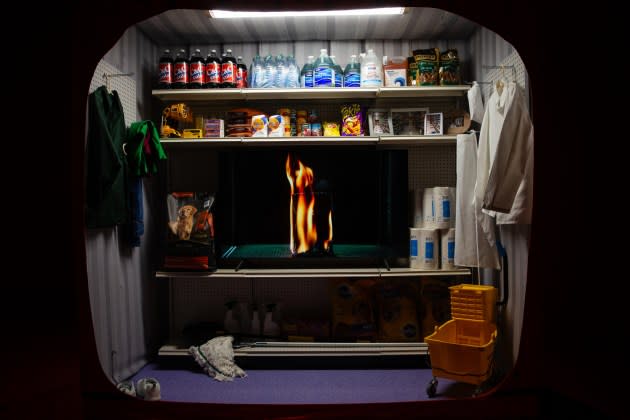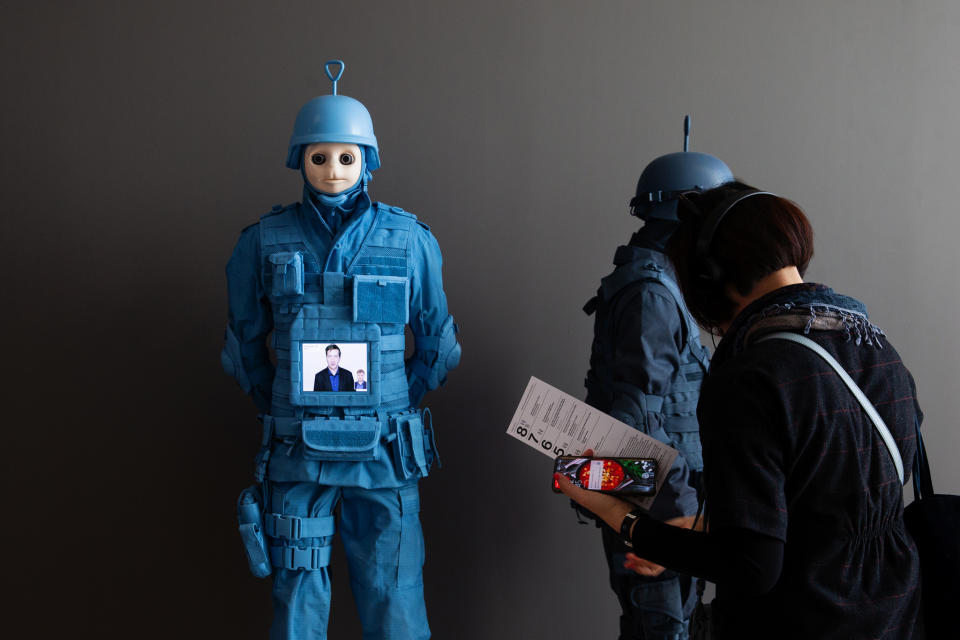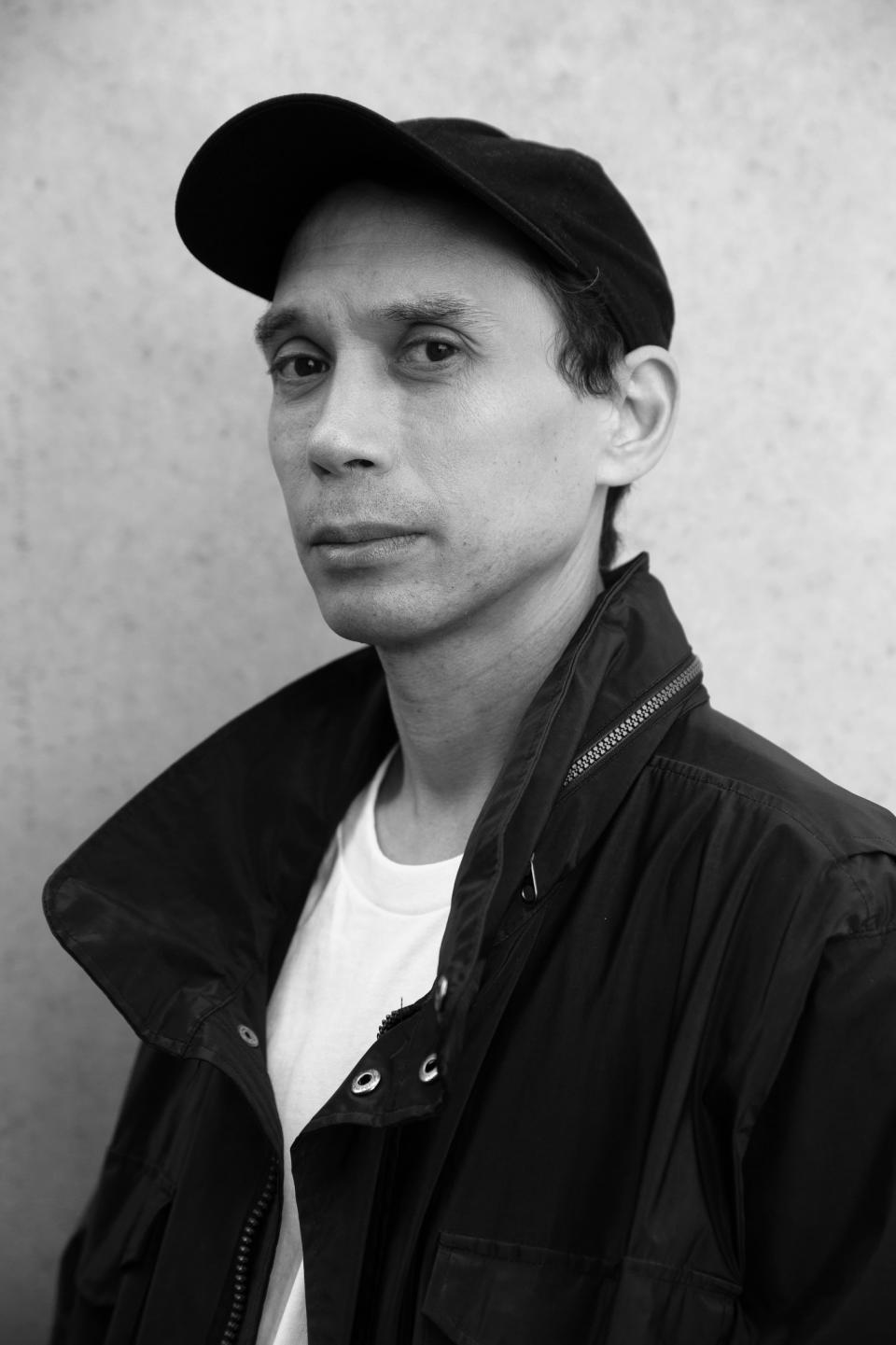Josh Kline’s Survey at the Whitney Museum Presents a Future Shaped by Technology and Climate Change

One of Josh Kline’s sculptures is melting on the fifth floor of the Whitney Museum. It has been melting for several months.
The artist’s performative sculpture “Domestic Fragility Meltdown” contains several wax houses, which slowly liquify atop a heated metal plate and disappear down a drain. The melted remnants are then recycled back into a new sculpture, ready to melt again.
More from WWD
Kit Connor on Fashion, Acting and Finding His Second Home on Set
Meow Wolf Debuts Colorful '80s-inspired Tracksuits in Latest Apparel Drop
The regeneration is a reassuring metaphor, but Kline’s climate change message is a bit darker when applied to the real world. “You know, the sad reality is once society melts itself down, it’s going to be hard to put it back together,” says Kline.
“Josh Kline: Project for a New American Century,” which closes Aug. 13, is the artist’s first museum survey in the United States. The exhibition, installed over two floors of the museum, marks a unique opportunity for the New York-based artist to link the various ongoing “chapters” of his work, which interrogates the impact of technological progress on modern society.
“A lot of the work that I’ve made has either never been shown in New York, or never been shown as an installation here, or never been shown at scale,” says Kline, who is represented by 47 Gallery in New York.
Kline uses sculpture, installation and video to paint an often dire portrait of the near future. There are tech chimeras — blenders and laptops of varying brand prestige that have been spliced and conjoined with patriotic tape — from his 2017 series “Class Division”; there are Teletubbies in military gear and IV drips with unsavory ingredient formulas. There are capsules of corporate ephemera, inspired by the file boxes carried by laid-off office workers, installed inside virus-shaped globes hanging from the ceiling. Titled “Contagious Unemployment,” Kline made that series of sculptures several years before the COVID-19 pandemic.

In a neighboring room, bodies — not real bodies, but models of real people — lie dormant in plastic bags on the ground. The professionally attired cast are unemployed office workers whose jobs were at risk of being eliminated with the advance of artificial intelligence and automation. Although now a prevalent topic in 2023, Kline originally made the works in 2016, years before the public release of platforms like ChatGPT.
Although much of the exhibition feels hyper-current, Kline’s pieces tend to imagine a near future. There’s an uncanniness to much of his work, both in his portrayal of familiar objects and figures and also in the way that several of his pieces have preceded mass societal discussion around topics like AI and mass contagions.
His most recent chapter of work is “Climate Change.” On the top floor of the museum, Kline’s immersive installation “Personal Responsibility” invites guests to wander among campsites set in a hypothetical near future that has been devastated by climate change. The immersive installation features fictional video interviews with the essential workers working out of the tents and SUV. A recent short film, “Adaptation,” depicts a Manhattan cityscape that has been altered by a drastic change in sea level.
“The 21st century is going to be defined by these massive flows of refugees and migrants fleeing the flooding coasts and other sites that are going to be devastated, or at least transformed beyond recognition by the changes in climate that are being brought about by industrial civilization,” says Kline of his “Climate Change” chapter. “I always knew that had to be the core of this larger project, because it’s going to shape everything.”
Kline’s work elicits a strong emotional — often visceral — response. It’s difficult not to react to the sight of bodies in bags to be discarded, or an apocalyptic future society devastated by climate disaster. But they’re also familiar sights rooted in a thread of truth, stories of impending environmental gloom and AI doom so ubiquitous in news media that it’s gotten easier to scroll past them, desensitized to the urgency.
Kline’s work is at times difficult, but accessible and instantly recognizable to the broad range of visitors coming through the museum’s doors. The exhibition is a conversation starter.
“Good art should function on multiple levels, and be capable of having conversations with multiple people, so that if someone comes in who has a knowledge of art history, who knows about the history of video art, or sculpture, or recent political history, that these things are all there in the work for them,” he says. “But then there’s also a layer that’s accessible to people who know nothing whatsoever about art. Who can have an experience with it, too, and who I can have a conversation with about the issues that I’m interested in.”
Asked whether any reactions to the show have surprised him shortly after the show’s opening this spring, Kline notes that he’s drawn to new perspectives of his work.
“There are always little revelations,” he says. “I don’t like to prescribe what people should take away from the work, and so it’s always interesting for me to see things in the work that I haven’t put there, at least not consciously. People look at it and they see something that is definitely there, but that I didn’t even think of.”
Kline, originally from Philadelphia, studied filmmaking at Temple University before turning his focus to contemporary art. Now in his mid-40s, his background in film continues to inform his work, both in content (he’s working on a screenplay) and his approach to an audience.
“In film school one of the first lessons is always to think about your audience,” says Kline, who will bring his work to L.A. next year for a solo exhibition at MOCA. “The message is always that half the work happens in the mind of the audience when they see it — and without that, the work isn’t complete.”

Launch Gallery: Inside Josh Kline's Project for a New American Century
Best of WWD


